Students will step onto the stadiometer in lightweight clothing, without shoes, hair accessories, or head adornments, and stand straight. They should keep their heels together and arms at the sides of the body. The entire body should be in contact with the stadiometer (heels, buttocks, and upper part of the back). The head should be oriented so that the top protrusion of the ear's tragus and the lower edge of the eye socket (Frankfort Plane) are in the same horizontal plane. They should take a deep breath and hold it. The measurement will be taken at that moment, and the highest point of the head will be used as a reference, with the hair compressed.
Two measurements will be taken.
Weight is recorded with an approximation of 100 grams.
Example: a result of 32 kg and 200 g is recorded as 32.2 kg. The area in which the evaluation through the Level I Observation Test: backward, lateral, and frontal falls will take place must be isolated so that students do not see their peers' responses to the exercise.
8.2. BODY WEIGHT
Students will step onto the scale without shoes, in lightweight clothing, and without accessories. They should position themselves in the center of the scale platform, distributing their weight evenly between both feet, facing forward, with arms along the body, and without making any movements.
Two measurements will be taken.
The height reading should be recorded with an approximation of 1 cm.
Example: a result of 1 m and 7 cm is recorded as 107 cm.
8.3. BODY MASS INDEX (BMI)
Body weight in kilograms divided by the square of height in meters (kg/m2).
OBSERVATION TEST LEVEL I: BACKWARDS FALL, SIDEWAYS FALL AND FORWARD FALLS (FRONTAL AND ROLL-OVER).
8.4. BACKWARDS FALL
Initial or starting position:
The controller and the student stand facing each other. The controller holds the student's wrists from above, ensuring that the student's palms are facing downward (looking at the ground to prevent them from grabbing the controller when released) with arms extended. From this position, the student will bend their knees until they reach below 45°, with the buttocks outside the base of support (coccyx behind the heels), and thus, in a position of imbalance. The controller gradually lowers the student's center of gravity without touching the marker (maximum to the height indicated by the marker: 5 cm).

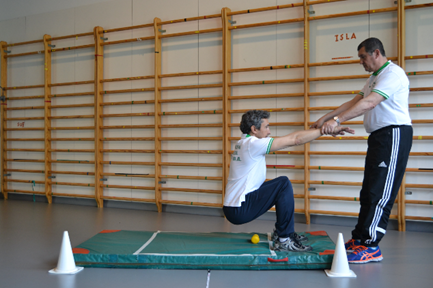
Proceed:
During that descent, and once a flexion greater than 45º has been reached, the instructor will release the student's wrists without prior notice to induce an unexpected backward fall.
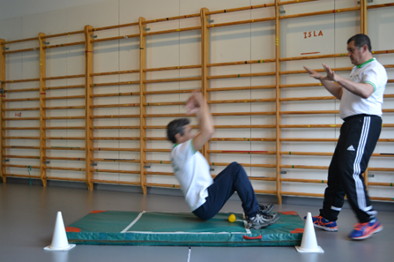
Data Recording:
Once the wrists have been released, the observer will note in the Observation Test Level I: Backwards Fall (Annex 4), the occurrence or non-occurrence of the mentioned action concerning different body segments.
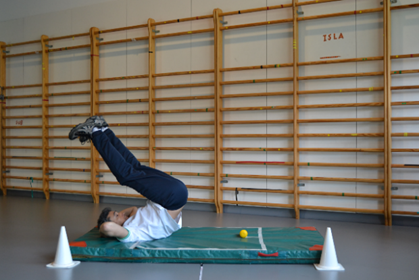
8.5. FORWARD FRONTAL FALL
Initial or starting position:
The student will be positioned on their knees, with their knees spaced shoulder-width apart. The body should be straight and fully extended, maintaining an upright posture. Hands should be placed at the sides, resting naturally. The neck should be straight, maintaining an anatomical position with the head facing forward.
The instructor will stand behind the student. The instructor will pass a belt or rope around the student's chest, positioned just below the armpits.

Proceed:
The instructor will begin to unbalance the student to approximately a 45-degree angle. At a moment of their choosing, the instructor will release the belt or rope unexpectedly, surprising the student.
Data Recording:
Once the belt is released, the observer will note in the Observation Test Level I: Forwads Frontal Fall (Annex 5) whether the student acquires or not the motor protective actions mentioned and related to different body segments (head turn protection position and protection position without head turn).
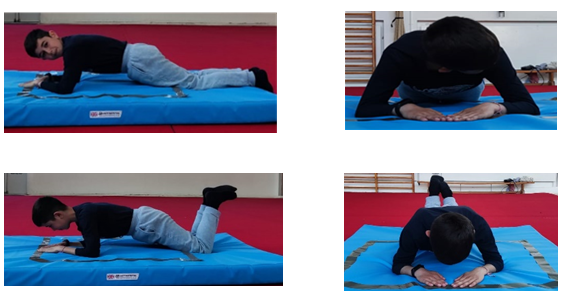
Special attention will be given to ensuring that the head does not touch the ground (most important) and turning the face to one side (better position); forearms will be fully supported, forming an angle ≤90º. During contact with the mat, fingers are extended, closed, palm down, with the torso locked and extended. Lastly, the hip will be locked.
8.6. SIDEWAYS FALL
Initial or starting position:
The student will assume a deep squat position, characterised by a full flexion of the knees. The feet should be placed close together, with the weight supported on the metatarsus. Hands should rest gently on the knees. The trunk should be fully extended, maintaining a straight and upright posture and the should also be extended, with the student looking straight ahead, ensuring the neck is aligned with the spine.
The instructor will stand behind the student.
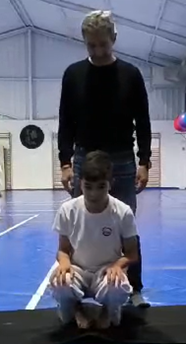
Proceed:
The instreuctor will push the student laterally, without warning (either to the right or the left). The student must respond with a protected sideways fall, following the patterns outlined in the table.
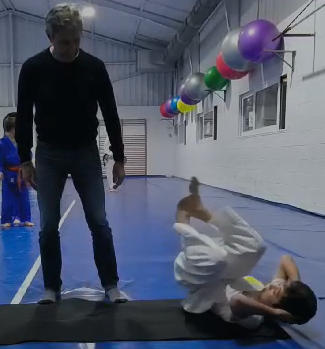
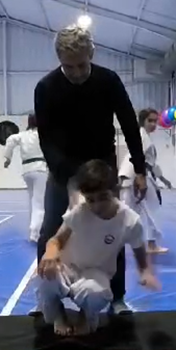
Data Recording:
The observer will note in the Observation Test Level I: Sideways Fall (Annex 6), the occurrence or non-occurrence of the mentioned action concerning different body segments.
8.6. FORWARD ROLL-OVER FALL
The authors of the protocol contend that, at the initial level, there is no feasible means to safely perform the unintentional roll-over front fall test for the students. The complexity of this fall, owing to rotations along various body axes (longitudinal and transversal), combined with the low starting height, precludes the adoption of a protective and secure posture.
Like any other generic motor skill, the level of competency achieved, its assimilation, and subsequent automation, will be assessed through the correct performance of the skill.
Accordingly, the forward roll-over fall will be evaluated through the correct execution of the intentionally performed protective movement. This will be assessed using Annex 7. Consequently, the pretest-posttest protocol is set aside, with only one data collection occurring at the conclusion of the intervention (Annex 7).
Initial or starting position:
The student will begin in a quadruped position, ensuring that both hands and knees are firmly placed on the ground. The arms and elbows should be fully extended, creating a strong, stable line from the shoulders to the hands. The head should be slightly lifted, not tilted upward or downward, maintaining a straight-ahead gaze.

Proceed:
The student will perform a forward rolling fall as follows:
Phase 1: The student will place the turning hand between the opposite hand (which rests on the ground) and the knee on the same side.
Phase 2: The student initiates a forward imbalance, beginning to roll over the turning arm without any discontinuity or striking the arm, progressing until the shoulder contacts the ground. Concurrently, the head should be turned and flexed to protect it on the opposite side of the roll.
Phase 3: The student will roll diagonally across their back, from the shoulder to the opposite hip, while maintaining hip flexion.
Phase 4: In the final phase of the fall, the students will bring their hands to their head to shield it from potential impacts or perform a forearm strike on the ground. The legs should remain semi-flexed and never crossed.
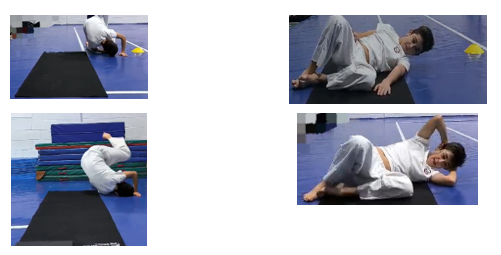
Data Recording:
The observer will note in the Observation Test Level I: Forward Roll-over Fall (Annex 7), the occurrence or non-occurrence of the mentioned action concerning different body segments.